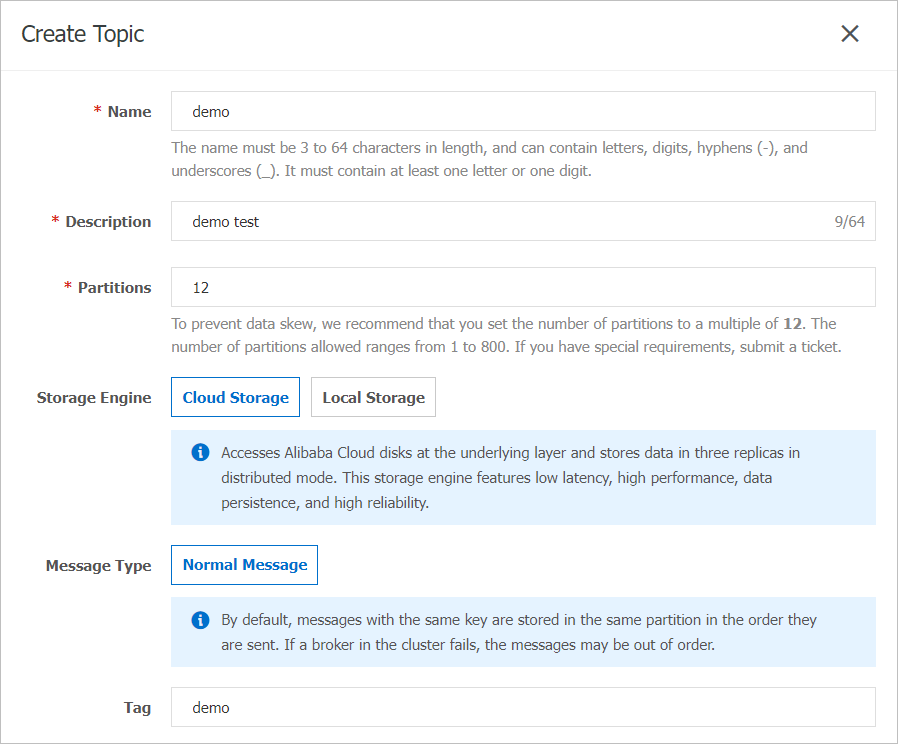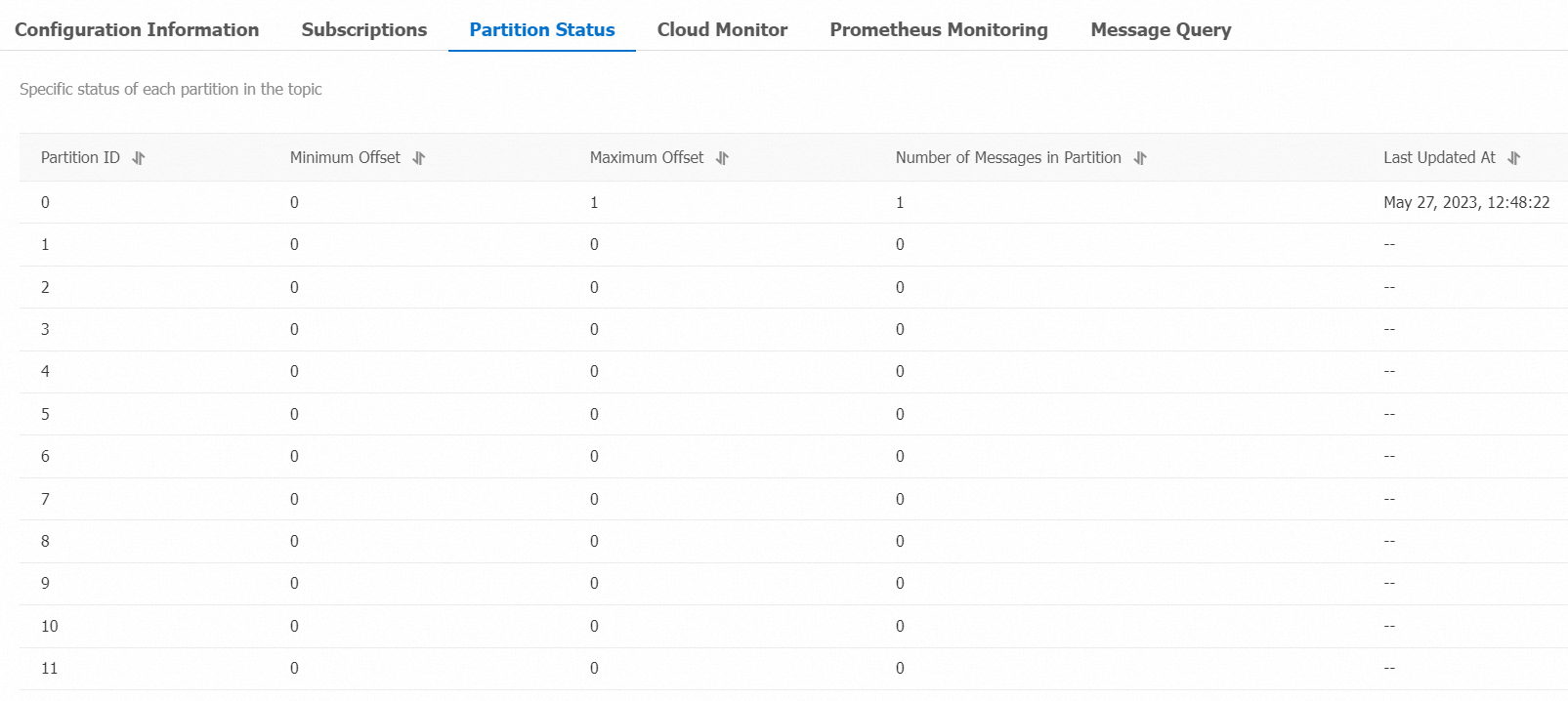After you purchase and deploy a ApsaraMQ for Kafka instance, you can send messages in the ApsaraMQ for Kafka console to check whether the broker is normal with efficiency.
Prerequisites
A ApsaraMQ for Kafka instance is purchased and deployed, and it is in the Running state.Procedure
To perform a quick test on the ApsaraMQ for Kafka broker, perform the following steps:
You can repeat Steps 2 to Step 4 multiple times. If all repeated steps are successful, the broker works as expected.
Create a topic
In the Resource Distribution section of the Overview page, select the region where your instance is deployed.
ImportantYou must create topics in the region where your application is deployed. When you create a topic, select the region where your Elastic Compute Service (ECS) instance is deployed. A topic cannot be used across regions. For example, if your message producers and consumers run on ECS instances that are deployed in the China (Beijing) region, create topics in the China (Beijing) region.
On the Instances page, click the name of the instance that you want to manage.
In the left-side navigation pane, click Topics.
On the Topics page, click Create Topic.
In the Create Topic panel, configure the parameters and click OK.

Parameter
Description
Example
Name
The topic name.
demo
Description
The topic description.
demo test
Partitions
The number of partitions in the topic.
12
Storage Engine
NoteYou can select the type of the storage engine only if you use a Professional Edition instance. If you use a Standard Edition instance, cloud storage is selected by default.
The type of the storage engine that is used to store messages in the topic.
ApsaraMQ for Kafka supports the following types of storage engines:
Cloud Storage: If you select this value, the system uses Alibaba Cloud disks for the topic and stores data in three replicas in distributed mode. This storage engine features low latency, high performance, durability, and high reliability. If you set the Instance Edition parameter to Standard (High Write) when you created the instance, you can set this parameter only to Cloud Storage.
Local Storage: If you select this value, the system uses the in-sync replicas (ISR) algorithm of open source Apache Kafka and stores data in three replicas in distributed mode.
Cloud Storage
Message Type
The message type of the topic. Valid values:
Normal Message: By default, messages that have the same key are stored in the same partition in the order in which the messages are sent. When a broker in the cluster fails, the order of the messages may not be preserved in the partitions. If you set the Storage Engine parameter to Cloud Storage, this parameter is automatically set to Normal Message.
Partitionally Ordered Message: By default, messages that have the same key are stored in the same partition in the order in which the messages are sent. When a broker in the cluster fails, the messages are still stored in the partitions in the order in which the messages are sent. Messages in some partitions cannot be sent until the partitions are restored. If you set the Storage Engine parameter to Local Storage, this parameter is automatically set to Partitionally Ordered Message.
Normal Message
Log Cleanup Policy
The log cleanup policy that is used by the topic.
If you set the Storage Engine parameter to Local Storage, you must configure the Log Cleanup Policy parameter. You can set the Storage Engine parameter to Local Storage only if you use an ApsaraMQ for Kafka Professional Edition instance.
ApsaraMQ for Kafka provides the following log cleanup policies:
Delete: The default log cleanup policy. If sufficient storage space is available in the system, messages are retained based on the maximum retention period. After the storage usage exceeds 85%, the system deletes messages from the earliest stored message to ensure service availability.
Compact: The Apache Kafka log compaction policy is used. For more information, see Kafka 3.4 Documentation Log compaction ensures that the latest values are retained for messages that have the same key. This policy is suitable for scenarios such as restoring a failed system or reloading the cache after a system restarts. For example, when you use Kafka Connect or Confluent Schema Registry, you must store the information about the system status and configurations in a log-compacted topic.
ImportantYou can use log-compacted topics only in specific cloud-native components such as Kafka Connect and Confluent Schema Registry. For more information, see aliware-kafka-demos.
Compact
Tag
The tags that you want to attach to the topic.
demo
After the topic is created, it is displayed on the Topics page.
Send a message
Send a message to the topic that you created.
On the Topics page, find the topic that you want to manage, and choose in the Actions column.
In the Start to Send and Consume Message panel, configure the required parameters to send a test message.
Set the Method of Sending parameter to Console.
In the Message Key field, enter the key of the message. For example, you can enter demo as the key of the message.
In the Message Content field, enter the content of the message. For example, you can enter {"key": "test"} as the content of the message.
Configure the Send to Specified Partition parameter to specify whether to send the message to a specified partition.
If you want to send the message to a specified partition, click Yes and enter the partition ID in the Partition ID field. For example, you can enter 0 as the partition ID. For information about how to query partition IDs, see View partition status.
If you do not want to send the message to a specified partition, click No.
Use Message Queue for Apache Kafka SDKs or run the docker commands that are displayed in the Start to Send and Consume Message panel to consume the message.
Set the Method of Sending parameter to Docker. Run a Docker container to produce a test message, and then consume the message.
Run the docker commands that are provided in the Run the Docker container to produce a sample message section to send a test message.
Run the docker commands that are provided in the How do I consume a message after the message is sent? section to consume the message.
Set the Method of Sending parameter to SDK and click the link to the topic that describes how to obtain and use the SDK that you want to use. Then, use the SDK to send and consume a test message. Message Queue for Apache Kafka provides topics that describe how to use SDKs for different programming languages based on different connection types.
View the partition status
After you send a message to the specified partition, view the partition status.
On the Topics page, find the topic whose partition status you want to view, and choose in the Actions column.
Parameter | Description |
Partition ID | The ID of the partition. |
Minimum Offset | The earliest offset based on which messages in the partition are consumed. |
Maximum Offset | The latest offset based on which messages in the partition are consumed. |
Last Updated At | The most recent point in time when a message is stored in the partition. |

Query messages by offset
Log on to the ApsaraMQ for Kafka console.
In the Resource Distribution section of the Overview page, select the region where your instance is deployed.
On the Instances page, click the name of the instance that you want to manage.
In the left-side navigation pane, click Message Query.
On the Message Query page, select Search by offset from the Search Method drop-down list.
Select a topic name from the Topic drop-down list and a partition from the Partition drop-down list, enter an offset value in the Offset field, and then click Search.
Messages whose offset values are greater than or equal to the specified offset value are displayed. For example, if you specify 5 as the value of both the Partition parameter and Offset parameter, the system queries messages whose offset values are greater than or equal to 5 from Partition 5.
Table 2. Parameters that are included in message query results Parameter
Description
Partition
The partition from which the message is obtained.
Offset
The offset of the message.
Key
The key of the message. The key is converted to a string.
Value
The content of the message. The message content is converted to a string.
Created At
The point in time when the message was produced. The value is the timestamp that the producer recorded when the producer sent the message or the value is the same as the value of the timestamp field that you specified for
ProducerRecord.NoteIf you specified a value for the timestamp field, the specified value is displayed.
If you did not specify a value for the timestamp field, the local system time when the message is sent is displayed.
A value in the 1970/x/x x:x:x format indicates that the timestamp field is set to 0 or an invalid value.
You cannot specify a value for the timestamp field on clients of ApsaraMQ for Kafka V0.9 and earlier.
Actions
Click Download Key to download the key of the message.
Click Download Value to download the content of the message.
ImportantThe Message Queue for Apache Kafka console can display up to 1 KB of content for each message. If the size of a message exceeds 1 KB, the excess content of the message is omitted. If you want to view the complete message, download the message.
You can download up to 10 MB of message content. If the size of a message exceeds 10 MB, only the first 10 MB of message content can be downloaded.